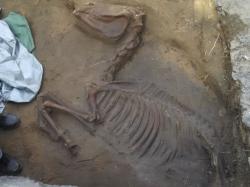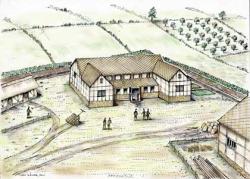INSTITUT SUPERIEUR D'ANTHROPOLOGIE
INSTITUTE OF ANTHROPOLOGY
ONLINE COURSES / COURS A DISTANCE
FALL TERM : OCTOBER 2015
REGISTER NOW
USA –  St Augustine - An archaeological dig was tucked next to a construction site of a new restaurant in downtown St. Augustine. "During the first day of the excavation, we ran across a bone," Halbirt said. "We knew we had something, but we didn't know exactly what it was." It turned out to be an entire horse skeleton, a horse burial. "Here we have the remains of a completely articulated small horse," Halbrit said, pointing to the bones. "This is the only horse burial we have ever uncovered here in the colonial downtown district," said Halbirt. He estimates, the horse is 200 years old, based on the ceramic artifacts found near it which date to the late 1700s. It was only a few feet below the ground. The city block where the skeleton was found used to be a place for horses 200 years ago. It was the site of the Spanish Dragoon Barracks. A dragoon "basically is a man on a horse with a gun," said Amanda LaPorta, a budding colonial cavalry expert. Essentially, this horse was most likely part of the colonial Spanish cavalry in St. Augustine. LaPorta believes – based on the skeleton's small size – it was a horse called a Marsh Tacky. "There's this subgroup of swamp ponies that are descendants of the original horses brought over from Spain."
St Augustine - An archaeological dig was tucked next to a construction site of a new restaurant in downtown St. Augustine. "During the first day of the excavation, we ran across a bone," Halbirt said. "We knew we had something, but we didn't know exactly what it was." It turned out to be an entire horse skeleton, a horse burial. "Here we have the remains of a completely articulated small horse," Halbrit said, pointing to the bones. "This is the only horse burial we have ever uncovered here in the colonial downtown district," said Halbirt. He estimates, the horse is 200 years old, based on the ceramic artifacts found near it which date to the late 1700s. It was only a few feet below the ground. The city block where the skeleton was found used to be a place for horses 200 years ago. It was the site of the Spanish Dragoon Barracks. A dragoon "basically is a man on a horse with a gun," said Amanda LaPorta, a budding colonial cavalry expert. Essentially, this horse was most likely part of the colonial Spanish cavalry in St. Augustine. LaPorta believes – based on the skeleton's small size – it was a horse called a Marsh Tacky. "There's this subgroup of swamp ponies that are descendants of the original horses brought over from Spain."
http://www.firstcoastnews.com/story/entertainment/events/st-augustine-450th/2015/06/09/in-archaeological-dig/28724673/
ROYAUME UNI –  Lincoln - A substantial medieval wall has been uncovered in an "unusual" location in Lincoln. Archaeologists working on the East West Link Road found the stones along with pottery from the 12th and 13 Centuries and some Roman remains. It is not yet clear if it was part of a larger structure or a free standing garden wall.Anthony Lee, archaeology curator at the county's museum The Collection, said: "It's an interesting place to find a [medieval] wall. "It's an area near the river that was subject to quite a bit of flooding during the medieval period so if it's a substantial wall it's an interesting discovery."
Lincoln - A substantial medieval wall has been uncovered in an "unusual" location in Lincoln. Archaeologists working on the East West Link Road found the stones along with pottery from the 12th and 13 Centuries and some Roman remains. It is not yet clear if it was part of a larger structure or a free standing garden wall.Anthony Lee, archaeology curator at the county's museum The Collection, said: "It's an interesting place to find a [medieval] wall. "It's an area near the river that was subject to quite a bit of flooding during the medieval period so if it's a substantial wall it's an interesting discovery."
http://www.bbc.co.uk/news/uk-england-lincolnshire-33064058
ROYAUME UNI –  Abermagwr - Archaeologists studying a previously unknown villa, found beneath fields in Abermagwr in 2011 after cropmarks were spotted during an aerial survey, say social and economic conditions in Roman west Wales allowed high-status residents to build large homes within farmland estates. No Romano-British villas had been found outside of south Wales before the summer survey in 2006. But analysis by Royal Commission experts led to a geophysical survey which revealed a large rectangular enclosure with a neat cobbled yard. Part of the earliest known slate roof in the region was also found as part of excavations which have “radically altered” historical knowledge of Roman life in Wales, according to archaeologists who describe the villa as “relatively modest”. A main block, the domus, was accompanied by three main rooms, a veranda, two projecting wings and a small room added at a later date to the rear of the building. Vessels from English production centres such as Poole Harbour in Dorset, Oxfordshire and the Malvern Hills were unearthed alongside locally-produced pots, bowls and platters, fragments of Samian ware from Gaul and sherds from a southern Spanish amphorae used to transport olive oil. Researchers believe the finds demonstrate “thriving” trade links between Ceredigion and the Roman world for three centuries. A fine glass drinking vessel, gaming counters and a brick with a dog paw print have raised hopes that more villas could lie buried across the region, where archaeologists also found coins included a bronze depiction of Emperor Constantine I, minted in Lyon in 314 or 315, and a denarius of Severus Alexander, minted in Rome almost a century earlier.
Abermagwr - Archaeologists studying a previously unknown villa, found beneath fields in Abermagwr in 2011 after cropmarks were spotted during an aerial survey, say social and economic conditions in Roman west Wales allowed high-status residents to build large homes within farmland estates. No Romano-British villas had been found outside of south Wales before the summer survey in 2006. But analysis by Royal Commission experts led to a geophysical survey which revealed a large rectangular enclosure with a neat cobbled yard. Part of the earliest known slate roof in the region was also found as part of excavations which have “radically altered” historical knowledge of Roman life in Wales, according to archaeologists who describe the villa as “relatively modest”. A main block, the domus, was accompanied by three main rooms, a veranda, two projecting wings and a small room added at a later date to the rear of the building. Vessels from English production centres such as Poole Harbour in Dorset, Oxfordshire and the Malvern Hills were unearthed alongside locally-produced pots, bowls and platters, fragments of Samian ware from Gaul and sherds from a southern Spanish amphorae used to transport olive oil. Researchers believe the finds demonstrate “thriving” trade links between Ceredigion and the Roman world for three centuries. A fine glass drinking vessel, gaming counters and a brick with a dog paw print have raised hopes that more villas could lie buried across the region, where archaeologists also found coins included a bronze depiction of Emperor Constantine I, minted in Lyon in 314 or 315, and a denarius of Severus Alexander, minted in Rome almost a century earlier.
http://www.culture24.org.uk/history-and-heritage/archaeology/art528407
INDE -  Telangana - How about having the four-hundred-year odd old history and culture of the region at your fingertips? That is, to be precise, what the Telangana State Department of Archaeology and Museums (TSDAM) has managed to achieve in its 101th year. Bringing technology closer to public and, in the process, making the city’s history and culture relevant to the younger generation, the TSDAM has developed a mobile app for Android OS users. The yet to be named app will soon be available on Google Playstore.
Telangana - How about having the four-hundred-year odd old history and culture of the region at your fingertips? That is, to be precise, what the Telangana State Department of Archaeology and Museums (TSDAM) has managed to achieve in its 101th year. Bringing technology closer to public and, in the process, making the city’s history and culture relevant to the younger generation, the TSDAM has developed a mobile app for Android OS users. The yet to be named app will soon be available on Google Playstore.
http://www.newindianexpress.com/states/telangana/400-Years-of-Telangana-in-a-Mobile-App/2015/06/09/article2856820.ece
TURQUIE –  Urla – As a part of a project initiated by Ankara University, a two-millennium-old Roman-era harbor will be rebuilt in Urla, one of the oldest coastal towns on the Aegean coast. The boats, loaders and stores that were used by the Romans will be reproduced according to their original designs. Following the construction, visitors to the harbor will be able to take a trip on Roman boats. The project, which will be built over an area assigned by the Urla Municipality, will feature storage rooms where the Romans stored their goods and at least two Roman-era boats. Although the archaeologists discovered that there was a church near the harbor, Erkanal said that they will not rebuild the church, as it did not belong to the specific Roman-era time period of the harbor.
Urla – As a part of a project initiated by Ankara University, a two-millennium-old Roman-era harbor will be rebuilt in Urla, one of the oldest coastal towns on the Aegean coast. The boats, loaders and stores that were used by the Romans will be reproduced according to their original designs. Following the construction, visitors to the harbor will be able to take a trip on Roman boats. The project, which will be built over an area assigned by the Urla Municipality, will feature storage rooms where the Romans stored their goods and at least two Roman-era boats. Although the archaeologists discovered that there was a church near the harbor, Erkanal said that they will not rebuild the church, as it did not belong to the specific Roman-era time period of the harbor.
http://www.dailysabah.com/history/2015/06/09/2000-year-old-roman-era-harbor-revived-in-urla
LAOS – Vientiane - Some 40 carved images of the Buddha thought to date back to the 17th century have been unearthed after a chance discovery by a farmer in agricultural land on the outskirts of the Lao capital, local press reported Tuesday. The relics were in a jar found by farmer Mr. Boupha Naovalath, 25, while digging a hole to trap crickets in his field in the capital's outer-urban Naxaythong District, said reports from Lao News Agency KPL. Believed produced during the heyday of the Vientiane-based Lane Xang Kingdom during the reign of King Souliyavongsa, it is thought the 20cm-high images may have been buried for safekeeping during a period of extended conflict with the Kingdom of Siam centered on modern-day Bangkok, Thailand.
http://news.xinhuanet.com/english/2015-06/09/c_134311962.htm?